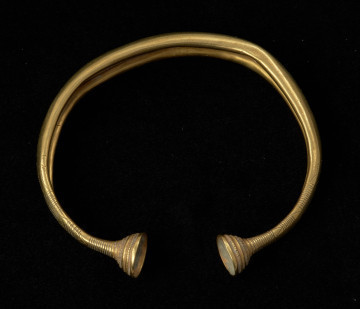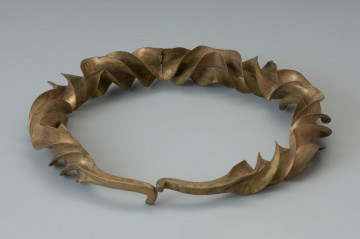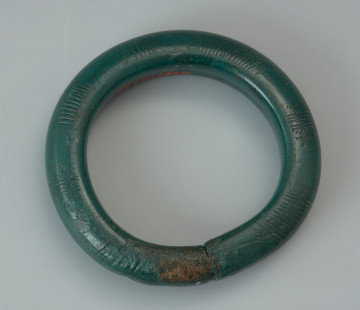
A bracelet with stamped ends
around 900 p.n.e. — 750 p.n.e.
National Museum in Szczecin
Part of the collection: Bronze Age
The bracelet is made of a relatively thin gold plate. This delicate specimen is decorated with groups of transverse incisions on the bail and circular engravings on the impressive, so-called stamped ends resembling small bowls or thimbles. Goldene Eidringe (oath rings) is how Christian Jürgensen Thomsen first named this type of bracelet in 1837. The term has been adopted in the professional literature. The ring came from a hoard discovered during ploughing, probably around the middle of the 19th century. It consisted of three bangles of the same type, which were placed in a clay vessel. It was purchased to enrich the collection of the Society of History and Antiquities of Pomerania (Towarzystwo Historii i Starożytności Pomorza) in Szczecin from Dreher, the owner of the estate in Orle. At the end of World War II, the hoard was evacuated to western Germany. The bracelets returned to Szczecin in 2009 due to the Polish-German exchange of old archaeological collections. Ornaments with stamped ends originate from the Nordic culture and are characteristic of the Late Bronze Age, mainly in southern Scandinavia (most are found on the Danish islands) and the Mecklenburg-Brandenburg-Pomerania zone. In Pomerania, even before 1945, about 30 Eidringe bracelets were recorded, among which as many as 24 were made of gold. Three gold specimens from Orle and one from Lębork have survived to the present day; both hoards are stored in the National Museum in Szczecin. Single gold bracelets may also be found in a museum in Berlin.
Dorota Kozłowska
Other names
Eidringe; oath rings
Author / creator
Dimensions
the entire object: height: 1 cm, width: 6 cm
Object type
bracelet, body adornment
Technique
carving, casting, bending, tapping
Material
gold
Origin / acquisition method
legal transfer
Creation time / dating
Creation / finding place
Owner
National Museum in Szczecin
Identification number
Location / status

around 900 p.n.e. — 750 p.n.e.
National Museum in Szczecin

around 600 p.n.e. — 400 p.n.e.
National Museum in Szczecin

around 1100 p.n.e. — 1000 p.n.e.
National Museum in Szczecin
DISCOVER this TOPIC
Castle Museum in Łańcut
DISCOVER this PATH
Educational path